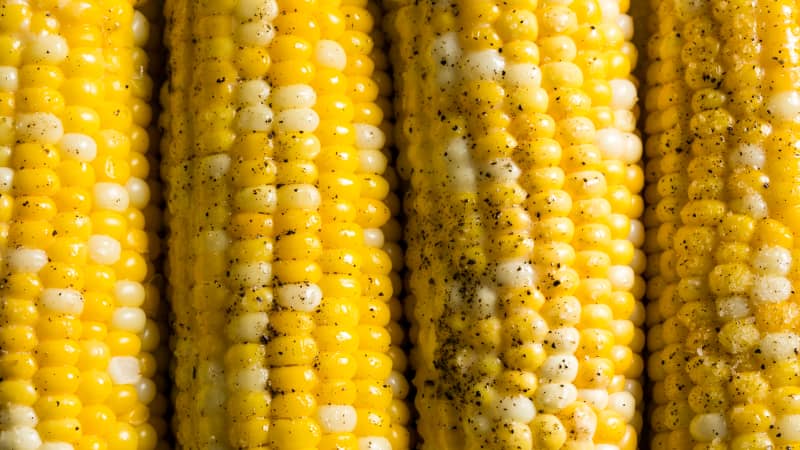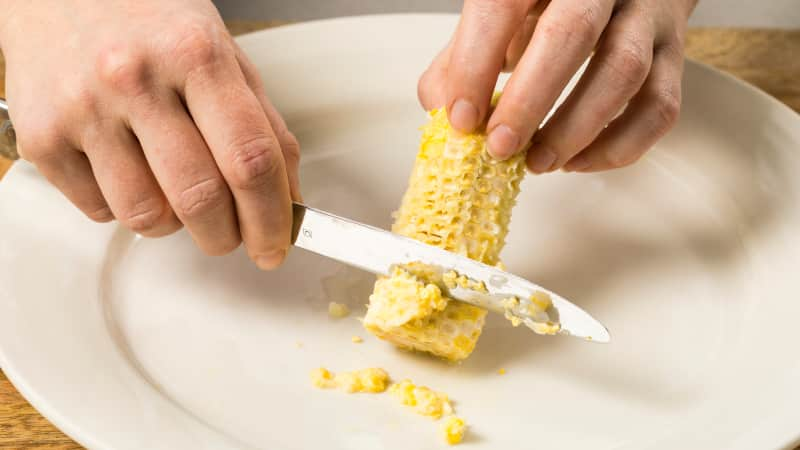If you’ve long thought that storing corn in the fridge is a bad idea, that sugar in the cooking water will make corn sweeter, and that you don’t need a recipe to nail perfectly tender kernels, read on. Our insights may surprise you.
10 Good Things to Know About Fresh Corn
Published Aug. 22, 2019.

1. How to Choose a Good Ear
To see if corn is at its best, you don’t need to peel back the husk and silk (which makes ears less desirable for other shoppers). Instead, gently press on the kernels through the husk; they should feel tightly packed, plump, and firm. The silk should look white and clean, and the husk should be green and pliable and closely wrapped around the ear. (And even if you shop at a market that allows you to shuck the corn on site, only do this if you plan to eat the corn that day, since the exposed kernels will be prone to drying out.)
2. All Colors of Corn are Equally Sweet
The color of corn is an indication of its carotene content, not its sugar content. Furthermore, many of the corn varieties found in supermarkets today have sugar contents approaching 35 percent. That’s almost three times sweeter than the varieties of corn sold decades ago, and it’s true whether you buy ears that are yellow, white, or bicolor.

3. It's Fine to Store Corn in the Fridge
While corn plants are sensitive to chilling injury, harvested ears of corn actually benefit from cold storage. And the colder the storage temperature, the better—as long as the corn doesn’t freeze. That’s because cold temperatures, along with humidity, slow the rate at which the corn’s sugar turns to starch; the moist air of a refrigerator also transfers heat from the corn to the environment more efficiently than dry air does and prevents the kernels from drying out.
To help keep the kernels as moist as possible: Place the unhusked ears in a wet paper bag inside a plastic shopping bag before storing them in the fridge.
4. Most Corn Will Stay Sweet for Days
While older varieties of corn would convert about half their sugar to starch within 24 hours of being picked, that conversion occurs more slowly in the supersweet varieties sold at most markets today. Most will stay sweet for four to seven days after being picked.
5. Easiest-Ever Way to Shuck Corn
Odd as it might sound, we’ve found that the easiest way to shuck corn is to briefly microwave it and then shake it, which makes the husk and silk slide right off. The cob will heat up a bit, but the kernels won’t be cooked.
Here’s how to do it: Cut off stalk end of cob just above first row of kernels. Microwave 3 or 4 ears at a time on plate for 30 to 60 seconds. Hold each ear by uncut silk end; shake up and down until cob slips free, leaving behind husk and silk.
6. Don't Bother Seasoning the Cooking Water
A corn kernel’s skin is virtually impenetrable to seasonings. In taste tests, we couldn’t tell the difference between corn cooked in water and corn cooked in a combination of water and milk. Likewise, corn cooked in water that had been seasoned with sugar or salt tasted no different from corn cooked in plain water. We found that the only way seasonings migrate into the kernels is by first being absorbed by the cob, and that takes far too long to be feasible.
Bottom line: You’re better off seasoning corn at the table.
7. Foolproof Way to Boil Corn
In our Foolproof Boiled Corn recipe, bringing the water to a boil, shutting off the heat just before adding the corn, and then covering the pot ensures that the corn’s temperature will rise to between 150 and 170 degrees—the sweet spot where its starches have gelatinized but little of its pectin has broken down. The result: perfectly sweet, snappy kernels every time.

Boiled Corn for a Crowd
Our recipe for Foolproof Boiled Corn works best when cooking six to eight ears. We adapted the method so you can cook as many as 24 ears at a time using a large cooler—which will also keep the corn hot for hours, without continuing to cook it.

8. A Neater Way to Strip Corn Kernels

The most common method of cutting corn from the cob involves standing the corn vertically, which causes the kernels to scatter.
Here’s an alternative that keeps the kernels more contained: Stand corn vertically and remove strip by slicing downward, but then place corn horizontally on cut side. Use narrower front third of chef ’s knife to slice downward along cob and remove kernels. With less distance to fall, kernels don’t scatter as far.
But if you make a lot of dishes calling for cut kernels, like corn chowder, Mexican corn salad, or sauteed corn, you may want to invest in a corn stripper. Our favorite is the OXO Good Grips Corn Stripper.
9. How to Milk Corn
Corn “milk” is the term for the sweet pulp and juices that are left behind when kernels are stripped from the cob. Many recipes call for capturing this liquid to add to dishes such as soups and chowders, risotto, or polenta.

Save the Cobs for Corn Stock
Briefly simmering stripped corn cobs can produce a surprisingly flavorful stock that can enrich polenta, cornbread, and vegetable soups. It also freezes well. Method: Cut 8 corn cobs into quarters. Place in large saucepan with 2 quarts water, bring to simmer, and cook for 15 minutes. Strain liquid through fine-mesh strainer. Yield: About 7 1/2 cups
10. The Best Way to Freeze Corn
Corn, which is botanically a cereal grain, freezes better than most vegetables because it is low in water and relatively high in starch and cellulose (which strengthens the kernels’ cell walls). Both starch and cellulose also make the kernels less susceptible to damage by ice crystal formation. The most important thing is to freeze corn fast in a single layer to help ensure that no ice crystals form on the surface and that the kernels don’t stick together once frozen.









